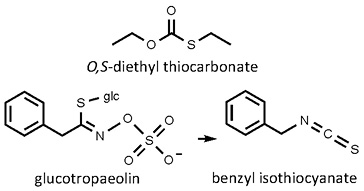 Tropaeolum majus
Tropaeolum majus
garden nasturtium • Indian cress
Back to “Salad herbs and herb mixtures: garden nasturtium (Tropaeolum majus); Indian cress (Tropaeolum majus); nasturtium (Tropaeolum majus)
Back to “Culinary herbs: garden nasturtium (Tropaeolum majus)*; Indian cress (Tropaeolum majus); nasturtium (Tropaeolum majus)”
Back to “Spices: garden nasturtium (Tropaeolum majus)fl, fr”
Tropaeolum majus (L.) Kuntze (Tropaeolaceae); kappertjie (Afrikaans); han jin lian (Chinese); Oostindische kers (Dutch); capucine, cresson d’India (French); Kapuzinerkresse, Indische Kresse (German); nasturzio d’India, cappucina maggiore (Italian); capuchinha-grande, nastúrio (Portuguese); capuchina (Spanish); Indiankrasse (Swedish)
DESCRIPTION The leaves, flowers, buds and seeds have a sharp, peppery taste and a sweet, fruity-sulphury aroma.
THE PLANT An annual or weakly perennial creeper with umbrella-shaped leaves and attractive red to yellow, spurred, edible flowers. The common name nasturtium (meaning “nose-twister”) is appropriate but potentially confusing (see also watercress, Nasturtium officinale). Tropaeolum is the only genus of the Tropaeolaceae, a family related to the Brassicaceae.1
ORIGIN A cultigen from the Andes region (Peru and Bolivia) and an ancient Inca food plant.2 Imported from the “Indies” by the Spaniards in the late 17th century, the plant (leaves and flowers) was used in Europe like cress in salads, hence the name “Indian cress” in various European languages.
CULTIVATION The plant is very easily propagated from seeds and often emerges spontaneously in the spring. Seeds can be sown in small pots in the greenhouse in early spring and seedlings planted out as soon as there is no longer any danger of frost. They thrive in full sun or partial shade. Poor soil and infrequent feeding is recommended because if plants become too vigorous they do not produce many flowers.3 Garden nasturtium is used for companion planting because it attracts aphids. It makes an easy and colourful addition to the herb garden (especially along paths) and is an ideal choice for hanging baskets.3
HARVESTING Leaves, flowers, flower buds and green fruits are picked as required (the last-mentioned in as little as four months after sowing). It is not worthwhile to dry the leaves or flowers but the buds and green fruits can be preserved by pickling in tarragon vinegar.
CULINARY USES The flowers are very popular as a colourful and edible garnish. This is the main culinary use of the plant but the leaves and flowers are also added to fresh salads for their peppery taste. Pickled flower buds or seeds can be used as substitute for capers.
FLAVOUR COMPOUNDS Tropaeolum species produce sharp-tasting mustard oils, compounds usually associated with the family Brassicaceae (e.g. mustard, horseradish and wasabi). All parts of the plant but especially the leaves contain high amounts of glucotropaeolin as the characteristic glucosinolate.4 When cells are damaged, the compound is enzymatically converted (by myrosinases) to the volatile and pungent benzyl isothiocyanate.4 The fruity aroma, however, is caused by a minor volatile compound called O,S-diethyl thiocarbonate, present at a level of only 0.1%.5

NOTES The tuber nasturtium (T. tuberosum) is an important staple food at high altitudes in the Andes, where potatoes cannot be grown.1
1. Andersson, L., Andersson, S. 2000. A molecular phylogeny of Tropaeolaceae and its systematic implications. Taxon 49: 721–736.
2. Mabberley, D.J. 2008. Mabberley’s plant-book (3rd ed.). Cambridge University Press, Cambridge.
3. McVicar, J. 2007. Jekka’s complete herb book. Kyle Cathie Limited, London.
4. Kleinwächter, M., Schnug, E., Selmar, D. 2008. The glucosinolate-myrosinase system in nasturtium (Tropaeolum majus L.): variability of biochemical parameters and screening for clones feasible for pharmaceutical utilization. Journal of Agricultural and Food Chemistry 56: 11165−11170.
5. Breme, K., Guillamon, N., Fernandez, X., et al. 2009. First identification of O,S-diethyl thiocarbonate in Indian cress absolute and odor evaluation of its synthesized homologues by GC-sniffing. Journal of Agricultural and Food Chemistry 57: 2503−2507.